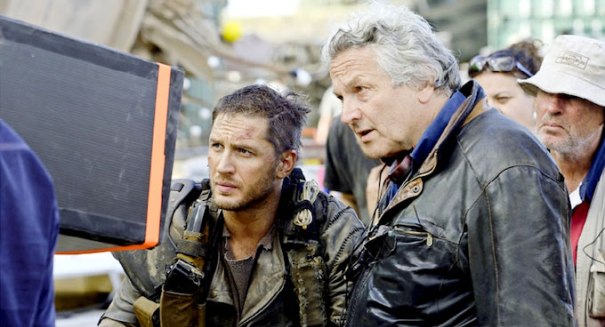
George Miller returns to his 'Road Warrior' roots in the rock opera, 'Mad Max: Fury Road' with Tom Hardy and Charlize Theron.
Sure, he’s directed movies like The Witches of Eastwick, Lorenzo’s Oil, Babe: Pig in the City and Happy Feet, but George Miller is synonymous with the post-apocalyptic world he created with the Mad Max series that made Mel Gibson a superstar. From the mastermind behind the Mad Max franchise, comes Mad Max: Fury Road, a return to the world of the Road Warrior, Max Rockatansky (now played by Tom Hardy).
In the film, haunted by his turbulent past, Mad Max believes the best way to survive is to wander alone. Nevertheless, he becomes swept up with a group fleeing across the wasteland in a war rig driven by an elite Imperator, Furiosa (Charlize Theron). They are escaping a Citadel tyrannized by the Immortan Joe (Hugh Keays-Byrne), from whom something irreplaceable has been taken. Enraged, the Warlord marshals all his gangs and pursues the rebels ruthlessly in the high-octane road war that follows.
Miller recently talked about returning to the iconic onscreen world he created.
In big action movies, there’s usually just one female. In this movie, there’s a slew of them. How do you feel about the whole girl power thing in Mad Max?
It came from the very first conceit of the movie. Instead of the MacGuffin being a thing, it should be human cargo – five wives capable of breeding an heir for a warlord. The rest of the movie followed organically from there. It couldn’t be a male stealing the women [from the warlord’s captivity], it had to be a female. It had to be a female road warrior. Growing up, I had no sisters. I had all brothers. I went to an all boys high school. I went to medical school at a time when there were very few women studying medicine. It was only after that that I was able to experience women through my two marriages. I also had a very strong mum. We’re seeing in the world now that women are emerging in a way as a unified, healing force in the world. It’s in the zeitgeist right now and that sort of crept into the movie. We basically shot the movie chronologically and in the beginning, [Max and Furiosa] are desperate. They literally try to kill each other and then they come to a point where they need each other out of mutual regard and mutual survival.
Action really drives the movie, but the music is an important element as well.
I don’t know if you guys know Junkie XL who composed this. It’s Junkie XL, aka Tom Holkenborg and this is the first movie where he’s taken a credit. Believe it or not when I started this movie, I intended to have no music except for the sound of the cars and the guitarist and the drummers. As the movie started to evolve in the cutting room, I realized this was almost a rock opera, but [the film] really needed a composer who [understood this]. [I was referred to] Junkie XL and I had never even heard of him before. We tried some music that had been written for other movies that hadn’t been used and it just fit. I don’t know if you know Tom [Junkie XL], but he studied law. He lectured in sound design in Holland. He started a faculty there. He’s got the full symphonic ability. Whatever you throw at him, he has the intellectual capacity and the artistic capacity to deal with it. He was just the right person for this movie. He glued so much of this movie together and modulated the passages through the movie. It’s very visual music. He’s a great composer. And a great guy. When you have someone who can explain what music is, how it’s almost mathematical in the way it’s structured, that was really exciting for me.
The movie shoot was in the middle of nowhere.
I wanted to shoot near my home in the Outback of Australia and we were rained out with unprecedented rain. We had to go from the east coast of Australia and take all of our equipment and the cast and crew and go to the west coast of Africa – Namibia.
This movie is a good continuation from the first three Mad Max films, yet it’s contemporary. How were you able to do that?
Thank you for acknowledging that because it’s so hard to do that. If we’re going to go back to this world, you surely can’t do what you did 30 years ago, but it had to be uniquely familiar. It’s like going back to your home town but seeing it through new eyes. Everything had changed in 30 years. The world had changed. Cinema had changed. Technology changed and this was an opportunity to blend all of that together. Mad Max 2 had 1,200 cuts. [Mad Max: Fury Road] has 2,700 cuts and [this film] is not much longer than [Mad Max 2]. Cinema is no doubt getting faster through commercials and music clips. This is a language where we’re speed reading now. This was a chance to enter a much more fully realized world. To be honest, before all these computer animated movies and talking pig movies, this new digital dispensation is really interesting. Although we had to shoot much of it old school, with the digital advancements, we were able to do so much. One of the most common uses of CGI in the movie was to change the color of the sky. I hope I was able to improve on the last [Mad Max] movies after 30 years or else I haven’t learned anything.

Mad Max: Fury Road is in theaters May 15.